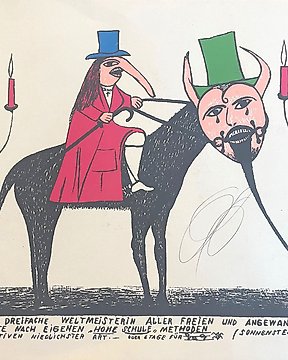
Friedrich Schröder-Sonnenstern (1892-1982) - sans titre
编号 82132679

编号 82132679

William TURNBULL (1922-2012)
Sans titre, 1963
Lithographie sur papier
Signée et datée de la main de l'artiste
Dimensions : 33 x 33 cm
Provenance : Éditions du Griffon, Neuchâtel
William Turnbull’s work resonates across cultural, geographical and historical divides and evades neat classification. His work would be equally at home in a museum of ancient artefacts as in a museum of contemporary art. […] While habitually linked with the ‘Geometry of Fear’ – a group of British sculptors…who rose to international prominence in the 1950s in the wake of Henry Moore and Barbara Hepworth – his work has a seriousness of purpose and depth of thought that marks it apart. He connects with just about every art group of the period, but at the same time was allied to none. This independent streak is a key characteristic of his life and work.
Turnbull was born in January 1922 in Dundee, the son of a shipyard engineer. He left school at 15, but attended evening art classes. One of his teachers spotted his talent and got him a job as an illustrator for the Dundee-based publishing house DC Thompson. He joined the RAF in 1941, training in Canada and flying in India and Ceylon (modern day Sri Lanka). […] Turning down a lucrative invitation to become a full-time commercial pilot, in 1946 he enrolled in the painting department at the Slade School of Fine Art in London. After a few weeks, he moved to the sculpture department where he met Paolozzi, who became a close friend.
Turnbull visited Paris in 1947 and moved there the following year. At that time, you could meet the legends of modern art without much difficulty. Turnbull knocked on Constantin Brancusi’s door and persuaded the great sculptor to let him in, spending an hour wandering about the studio. Fernand Léger welcomed him into his studio and talked at length about his work. Jean Hélion – married to Peggy Guggenheim’s daughter Pegeen – took Turnbull under his wing and invited him to parties attended by the Surrealists. […] The critic David Sylvester, who also lived in Paris, organised a join show of sculpture by Turnbull and Paolozzi at Erica Bausen’s legendary Hanover Gallery in Mayfair in February 1950. Brausen was also the dealer of Giacometti, Francis Bacon and Lucian Freud.
Short of funds, Turnbull settled in London later that year...and became involved with the recently formed Institute of Contemporary Arts. He was one of several young artists, including Richard Hamilton and the photographer Nigel Henderson, who formed the independent group, which is often seen as a point of departure for Pop Art. What singled Turnbull out was his interest in, and reinterpretation of, the powerful, simplified forms of ancient and non-western art.
Turnbull’s international reputation was established with his inclusion in the exhibition New Aspects of British Sculpture, held in the British Pavilion at the Venice Biennale in 1952. […] In the mid-1950s Turnbull formed relationships with American artists and collectors, including Mark Rothko and Barnett Newman. Alongside his sculpture, Turnbull always painted and he had separate studios for the two practices. If he had a problem or impasse with a sculpture, he would return to painting, almost paradoxically, working out the problem on a flat service, or vice versa.
In the 1950s he favoured bronze, and in the early 1960s he made a number of owrks comprised of bronze and carved wood… He wanted the materials to “speak for themselves”, an idea that originated in Japanese art. [… In 1962,] Turnbull had travelled to Cambodia, Japan and Singapore for the first time. Balance, equilibrium and gravity remained the defining features of Turnbull’s oeuvre. In the mid-1960s, that same approach was brought to other pre-manufactured materials, including steel, Perspex and fibreglass, and these remained his materials of choice through the 1970s.
His first marriage was to the concert pianist Katharina Wolpe in 1950. He married his second wife, the eminent sculptor and printmaker Kim Lim in 1960. She had come to London from Singapore to study at Saint Martin’s College of Art, and then at the Slade. Trips to the Far East with her proved inspirational for Turnbull, as his gnarled bronzes, which speak of any anxiety rooted in Parisian Existentialism, gave way to something more akin to Minimalism, rooted in an Eastern aesthetic.
In the early 1980s, Turnbull returned to the material that was his abiding love – bronze – producing works which, more than ever, connected with ancient pre-classical sculpture. An exhibition at the Serpentine Gallery in London in 1995, put Turnbull firmly back on the map (it was his first major show in a public space since his Tate Gallery retrospective in 1973).
Usually among artists of his standing, he was diffident when talking about himself, but was genuinely interested in the lives of others. […] But the idea of Turnbull as an ascetic, monk-like figure can be exaggerated. His works may connect with Cycladic and Neolithic art, but his eyes were always open to the modern world. His sons were champion skateboarders and the forms of their skateboards inspired a series of figurative works, while his great Idol bronzes of the 1950s refer in part to ancient figures of worship, but also to contemporary figures of worship: Hollywood screen idols, such as Marilyn Monroe. Turnbull navigated the distant past and the immediate present as if they were a Möbius strip, constantly turning in on each other. His art speaks of a timeless visual language.